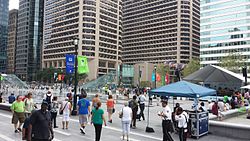Dilworth Park
| Dilworth Park | |
|---|---|
 Dilworth Park with Claes Oldenburg's sculpture Clothespin seen across the street | |
 | |
| Type | Urban park |
| Location | Philadelphia, Pennsylvania, U.S. |
| Coordinates | 39°57′11″N 75°09′54″W / 39.953°N 75.165°W |
| Area | 0.5 acres (0.20 ha) |
| Opened | September 4, 2014 |
| Operated by | Center City District[1] |
| Status | Open all year |
| Public transit access | SEPTA |
Dilworth Park is a public park and open space along the western side of City Hall in Center City, Philadelphia. The one-half-acre (0.20 ha) park opened to the public on September 4, 2014.
History
[edit]
Dilworth Park opened in September 2014. It is named in honor of Richardson Dilworth, who served as mayor of the city from 1956 to 1962. The current park was designed by KieranTimberlake, Urban Engineers and OLIN[2] and replaced Dilworth Plaza, designed by Vincent Kling in 1972.[3]
Centre Square
[edit]City Hall is located in what was originally named Centre Square. Centre Square was one of the five original public squares planned by William Penn in 1682. Centre Square was the geographic heart of the city until 1854, when Philadelphia expanded its city boundaries with the Act of Consolidation. Centre Square never became the social heart of the city as originally intended, but it remained in use until 1871, when construction of City Hall began.[4]
Penn planned for Centre Square to be:
a central square or plaza of ten acres to be bordered by the principal public buildings, such as the Quaker meetinghouse, the state house, the market house, and the schoolhouse. Despite the two riverfronts [Delaware and Schuylkill, Penn's city had an inward-facing design, focusing on this central plaza.[5]
However, the Delaware riverfront would remain the de facto economic and social heart of the city for more than a century.
[…] hardly anyone lived west of Fourth Street before 1703. Consequently Penn's design of a center square as the hub of his community had to be abandoned. The large Friends meeting house which was built in 1685 at the midpoint between the rivers was dismantled in 1702. Efforts to develop the Schuylkill waterfront likewise collapsed. Of the merchants, tradesmen, and craftsmen who can be identified as living in Philadelphia around 1690, 123 lived on the Delaware side of town and only 6 on the Schuylkill side. One of the latter, a tailor named William Boulding, complained that he had invested most of his capital in his Schuylkill lot, 'so that he cannot, as others have done, Remove from the same.' Not until the mid-nineteenth century, long after the city had spilled northward and southward in an arc along the Delaware miles beyond its original limits, was the Schuylkill waterfront fully developed. Nor was Centre Square restored as the heart of Philadelphia until the construction of City Hall began in 1871.[5]
Features
[edit]- grass lawns and landscaping,
- two large sloped glass stair canopies,
- a fountain/ice skating rink
- a cafe
- restaurant
See also
[edit]References
[edit]- ^ "CCD Parks". Center City District. Retrieved March 4, 2019.
- ^ Saffron, Inga (8 September 2014). "Dilworth Park has many irresistible features, but it's stiff, uncomfortable". The Philadelphia Inquirer. Archived from the original on September 9, 2014. Retrieved 22 October 2014.
- ^ Maule, Bradley (13 January 2014). "On Vincent Kling, 1916–2013". Hidden City Philadelphia. Retrieved 23 October 2014.
- ^ "Philadelphia Parks - William Penn vision of". fishtownonline. Archived from the original on 2015-04-29.
- ^ a b Weigley, RF; et al. (1982). Philadelphia: A 300-Year History. New York and London: W. W. Norton & Company. ISBN 0-393-01610-2.
- ^ McCutcheon, Lauren (25 September 2014). "Coffee Break: Rosa Blanca Dilworth Park". Philadelphia Daily News. Retrieved 22 October 2014.
- ^ Hepp, Chris (17 October 2014). "Ice skating coming soon to Dilworth Park". The Philadelphia Inquirer. Archived from the original on October 19, 2014. Retrieved 22 October 2014.
